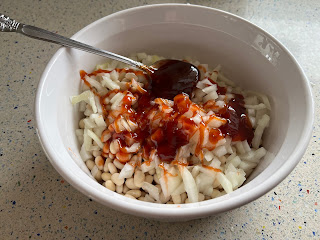My original intent was to do a roast with that whole chicken I froze what feels like a year ago. Instead, the recipes I found all used pieces, preferably leg quarters. When chicken was on sale, I bought two "picnic" packs of legs and thighs, planning to use at least some of it for Seder.
Like all "traditional" recipes of any origin, there are as many variations to this one as there are cooks. I'm most closely following the version on Unicorns in the Kitchen, as it suited my needs and did not involve removing the skin. I did leave out the bell pepper because it did not fit with the rest of the meal. You could add bell or hot peppers, whole small tomatoes, cabbage, or another leafy green and turn this into more of a stew than a braise.
It's traditional to serve this over rice, but Passover. I roasted some potatoes instead, because I really like roasted potato wedges, then another sheet of carrots in case there were guests who didn't want yet more potatoes in a potato-heavy week. It's always hard to cook for people you've never had over, plus the part where I've had exactly one party in two years and that was almost a year ago.
This recipe is very easy to double, or make even larger, without changing the cooking time, but you might need more pans. My largest skillet is the same width as the canning pot, which I almost ended up using. For the four servings I'm listing, a 12" should be sufficient.
This recipe also holds well. I put it in the serving casserole with some of the broth and kept it at 140º in the oven while we did the pre-meal part of the Seder. The meat stayed amazingly tender and just fell off the bones. Even microwaved leftovers (2 guests had car trouble and missed the event) were not tough.
4 leg quarters (or 4 thighs and 4 drumsticks)
kosher salt as needed
1/3 C bloomed saffron (see instructions)
Olive oil as needed
1 onion, thinly sliced
*1/2 tsp turmeric
pepper to taste
*1 cinnamon stick
1 C water, or as needed
2. Pat the chicken dry and season lightly with salt and pepper. If you bought skinless, drizzle a bit of olive oil into a large skillet with a lid. Heat over medium. Skin-on, omit the oil and just preheat the pan. Add chicken pieces, skin-side down, and cook to render any fat. Once browned, about 8 minutes, drizzle with 1 Tb of the bloomed saffron, turn, and brown the other side. Remove to a plate until after the next step.
3. If needed, add a bit of oil to the pan to coat the bottom. If you rendered enough fat out of the skin, no need. Add the onion slices and cook to soften, about 5 minutes. Add the turmeric and cinnamon stick and cook until fragrant.4. Add the chicken back to the skillet and nestle all pieces as flat as possible. Add water to come up about halfway around the chicken. You can use broth instead of water if you want, but I didn't find the need. It made a wonderful broth on its own during the simmer time. Cover, lower heat to medium-low, and cook 40 minutes, turning the chicken halfway through.5. Add the rest of the saffron water and cook another 10 minutes covered. Serve hot, with a generous ladle of sauce and onions on top.Difficulty rating π












































